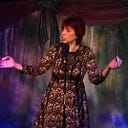5 Things We Need To Know About Creativity In The Age Of Uncertainty

1. Creativity is the energy of change. We may all agree that change is a constant, and that it is constantly picking up speed. Most of us accept that navigating the sea of uncertainty is quite a challenge, but not everyone is sold on the idea that we all share the capacity to be creative. One way of looking at the relationship between change and the creative force is by looking to nature, where change is continuous and unstoppable. For a biological cell, it is either change or die. A naturally-occurring enzyme within the cell facilitates a series of stages that results in transformation, and the process itself liberates energy at specific points, which is then available for use in other pathways.
The same is true for human beings. Creativity is a kind of spiritual or psychological “enzyme” that drives the ongoing change process. The “push” from within is the natural tendency toward growth and expansion, and our conscious choices determine the direction that change will take. Just as in nature, the process itself frees energy along the way, making it available for daily decision-making and problem-solving. In this way, creativity can unleash new possibilities over the entire course of life.
2. Creativity is the ability to adapt and grow. Creativity is like the “push” within a seed that propels it to form roots growing downward and tiny shoots that grow upward with enough force to defy gravity and break through the ground. It is the unseen current within all life that turns acorns into oaks. And in our own lives and inner selves, that “push” is the creative energy that human beings can direct toward realizing dreams, growing into more evolved versions of ourselves and flowing with the changes we cannot control.
3. Creativity is what powers your capacity to choose. Creativity is the part of every human being that allows us to see situations from a new perspective, to solve a problem when the old ways are not working — like figuring out a way to get the baby to take their medicine, or how to talk to mom when her memory is failing. In The Courage To Create, psychologist and researcher Rollo May describes creativity as “the process of bringing something new into being. It brings to our awareness what was previously hidden and points to new life.” Recognizing creativity as an inner strength that anyone can tap into may be enough to activate its power.
4. Believing you are creative can make you more creative. In a study published in the journal Psychological Science research subjects who stated they believe in the existence of luck were primed to believe they were being given the “lucky putter” in a golf-related task. These individuals performed better on the task than the control groups who did not believe in luck or were not primed to think they had the upper hand going into the task. The researchers based this study on previous work showing that “people’s belief in their capabilities to succeed in a particular situation may play a central role in turning seemingly irrational superstitious thoughts into directly observable performance benefits.”
The research demonstrates that we can choose our attitude toward change and about what it means to fail or succeed. And that if we believe we can learn something new or develop a skill set that is needed to realize a goal, we will be more likely to stick with the process until we have mastered it. Other studies show that belief is related to the sense of self-empowerment, optimism, hope and confidence. Quoting the Psychological Science article: “The more people believe in good luck, the more optimistic, hopeful, and confident they tend to be. On the performance side, it is well established that next to existing abilities and skills, one of the most important and consistent predictors of people’s performance is their perceived self-efficacy. The more confidence people have in their abilities to master a given task, the better they perform.”
5. Discomfort is an important feeling. Structure and predictability produce mental patterns that streamline our thinking process and save us from having to relearn the same things over and over. Getting outside the familiar structures can be uncomfortable, but creative pursuits can be a fun and fascinating way to develop the psychological resilience to manage those tensions just long enough for discovery and new perspectives to rise up. Discomfort is one of the most interesting psychological states to explore, and doing that in an atmosphere of psychological safety is an ideal pathway for creative growth.
Jude Treder-Wolff, LCSW, CGP, CPAI is a trainer/consultant and writer/performer with www.lifestage.org
